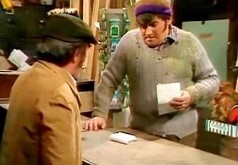Most people living in the UK over a certain age will be familiar with the Four Candles sketch from the 1976 Two Ronnies comedy show. For others, a quick education is available on the Wikipedia page for the sketch or simply watch it on You Tube. The essence of the sketch that we are interested in here is the ambiguity in the request made by the customer and the assumptions made by the shop keeper. What makes the sketch funny is that reasonable assumptions about what the customer was asking for turned out to be wrong. We will consider this in the context of a mathematical theorem, originally proposed in the 18th century and which over its history has been triumphed, discredited, wiped from maths teaching, rediscovered and used to crack German Enigma codes. Welcome to Bayes' theorem and its application to radar tracking.

Back to the Four Candles sketch. The customer asked the shopkeeper for "Four Candles" - or that's what the shopkeeper thought. There was ambiguity in the request, so it could have been heard as "Fork Handles", which is what the customer really wanted. Although the shopkeeper did not go through a conscious mathematical process to interpret what he heard, his brain did need to interpret what was said. Let's say that the brain assigned possible probabilities to two interpretations:
Probability ("Fork handles") = 0.8
Probability ("Four candles") = 0.7
which we interpret as meaning that, based on the audio alone, there was a slight preference for interpreting the request as being for Fork Handles. However, and this is where Bayes' theorem comes in, we do not make interpretations based only on the new data. We use context, or prior information. In other words, before anything was said, what was the customer more likely to ask for? This is the key difference. It was much more likely that the customer would come in to ask for four candles, than it was for fork handles. This prior information serves to weight the interpretation of audio. This, in essence, is Bayes' theorem, with all it's power of interpretation, contention, and debate.
Based on the prior expectations of what the customer might ask for, combined with the what the shopkeeper actually heard, he may come up with an interpretation such as:
Probability (he wants forks, given what he said) = low
Probability (he wants candles, given what he said) = high
In other words, even though the audio may marginally suggest that Fork Handles was what was asked for, the significant prior expectation that a customer would ask for candles rather than fork handles shifts the interpretation. We interpret data in the context of expectations all the time. Sometimes we get things wrong, but in the overwhelming number of times it is the right approach. Of course, the times we are wrong are the ones that are noted, either for comedy or tragedy.
Prior information helps us interpret new data. If something is more likely to happen, we can use that to help interpret the data. As an aside, to understand how Bayes' theorem may be considered contentious, consider the situation of allowing prior evidence to be considered in a court case for a criminal trial. Should the criminal history of a defendant be presented to a jury? We may interpret the facts of the crime differently if we know that the defendant is a career criminal. Is that right? Bayes' theorem tells us it is right to consider such prior evidence, but then great care is needed to make sure that the interpretation and presentation of new data (i.e. the evidence) is not biased by the prior.
Back to Fork Handles. Where did the fault lie between the customer and the shopkeeper? The customer should have realised that his ambiguous request was most likely to be misinterpreted by the shopkeeper because of prior expectations of what a typical customer would ask for. The customer should have overcome this by making his request unambiguous, for example, "I need a replacement fork handle since the existing handle on my garden fork has been damaged due to the heavy soil on my garden". The new data is sufficiently suggestive of the customer wanting fork handles that the prior expectation of candles is overridden. Not so good for comedy though!
In any situation where the new data is not 100% clear, we have to consider how the interpretation of that data might be handled incorrectly, given the prior expectation of the interpretation process. We may need to present the data in a way that avoids the ambiguity (as above for the fork handles). In the diagram below, a proposal is made to a meeting and most attendees agree, but one disagrees. The dissenting view is reported by a subtly different response (in the English language) using "Shouldn't", rather than "Should". The difference is tiny and easily misheard or misinterpreted if the proposer is looking for or expecting a confirming view. The responsibility lies with the dissenter to make their disagreement more plain ("I disagree, we should not do that" - so that the prior is overwhelmed)...
Subscribe to continue reading this article, it's free.
Free access to Engineering Insights, authored by our industry leading experts.
You will also receive the Cambridge Pixel newsletter which includes the latest Engineering Insights releases.
Fill in the form below and you will be sent an Instant Access link.


